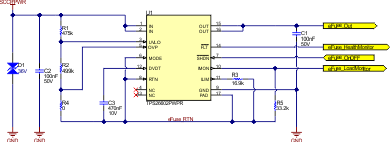SNVAA25A January 2022 – July 2022 DP83TD510E , ESDS302 , LM5155 , LM66100 , MSP430FR2476 , TL431LI , TLV3012
3.5 Protection Features
The PD includes the TPS2660 eFuse, which is a wide supply input voltage protection device with a full suite of protection features. This component offers overcurrent, overvoltage, and undervoltage protection as well as slew rate control. In addition, the eFuse provides reverse-polarity protection and integrates back-to-back FETs, which provide reverse-current blocking. The eFuse is enabled and disabled by the microcontroller with a shutdown pin. For system status monitoring, the device provides fault and a current monitor output, which is fed into one of the analog pins of the microcontroller. The PD has the eFuse configured in its auto-retry mode.

Figure 3-10 PD eFuse Circuit
The eFuse is directly supplied from the SCCP line and is placed before the isolated DC/DC converter system block.
It is important to note that every device connected to the SCCP line that has a bypass capacitor adds to the total capacitance of this line, which is also the SCCP communication bus in the system. The IEEE 802.3bu and 802.3cg standards specify that the total capacitance on the SCCP line must be under 2.64-µF (types A-D) and under 400-nF (type E) at the PSE output during detection. The input capacitance of the PD must be under 200-nF (types A-D) and under 400-nF (type E).